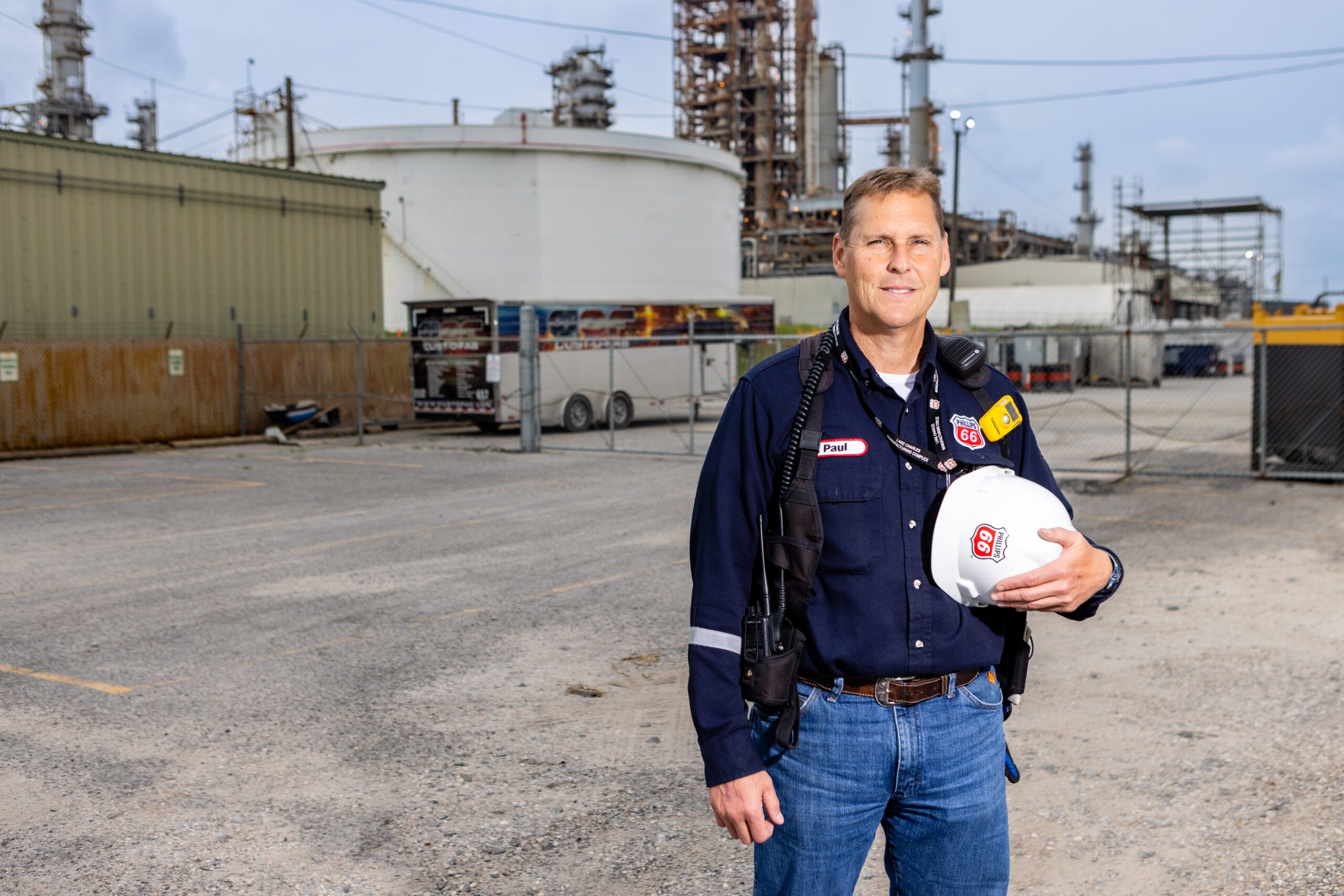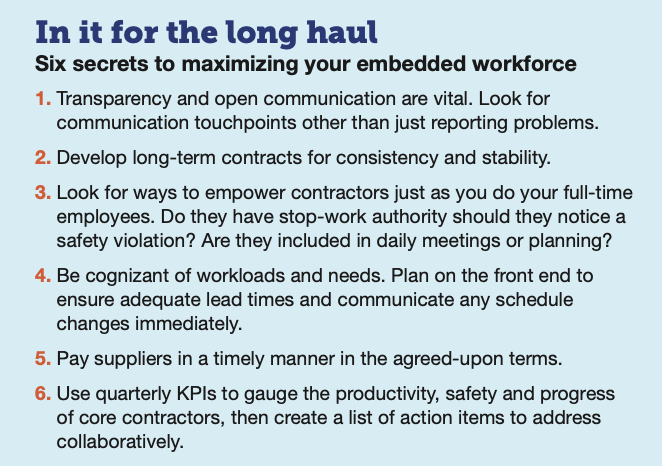At a time when limited manpower, accelerated schedules, and increasing construction volumes are in the headlines, an industrial owner’s attempts to build effective relationships with its contractors and suppliers can seem an impossible task.
In such an environment, skilled laborers often move around from job to job and state to state in search of higher wages, and that can have a negative impact in terms of productivity and safety as they must adapt to new work cultures and other unique jobsite dynamics.
Owners, therefore, have a vested interest in fostering and maintaining long-term relationships with their contractors, says Paul LaFleur, maintenance manager at Phillips 66 in Lake Charles. It all begins with a core belief that contractors are partners in the process, rather than merely laborers who get the job done.
“We feel it’s important to have a good partnership with our contractors,” LaFleur says. “A consistent workforce is familiar with the plant, and that pays big dividends.

“From a safety, efficiency and productivity standpoint, when we have people who already know our procedures and work policies, everything just flows more efficiently,” he adds. “Otherwise, there’s a steep learning curve. If the contractor isn’t successful, then we’re not successful.”
Consistency and stability are important for team building, so Phillips 66 seeks to develop long-term contracts with its contractor maintenance teams to create a stable workforce.
“That’s not possible in every situation, of course,” LaFleur says. “You’re going to have peak work periods where you’ll have to bring in additional manpower. But it’s critical to have a core group of contractors that’s there for the long term.”
It’s a typical scenario for many industrial contractors. Baton Rouge-based Brown & Root, for example, is embedded in several southeast Louisiana plants under regular maintenance contracts and often assists with major turnarounds, says COO Fred McManus.
“I have a 20- to 30-year history with a lot of these customers as a maintenance contractor, through Brown & Root and other companies,” McManus says. “For major turnarounds, we’ll commit typically 18 months before the outage, where our guys will be involved in the planning and preparations … then we’ll pull the team together to execute the outage.”
TEAM BUILDING CHECKLIST
Kenny Dukes, manager of procurement and materials at CITGO Petroleum in Lake Charles, says his plant “has quite a few nested service providers, so it’s important that we maintain strong relationships to keep things moving.”
Dukes, who oversees procurement and material movements at CITGO, approaches team building much like any other relationship. “The key is communication,” he says. “It’s important to develop a human relationship rather than a digital one, so we try to get ‘face time’ with our suppliers and understand them. If you can understand their business model and the challenges they face, it makes it easier to come to an agreement.
“And when situations arise, it’s easier to manage them if you have an existing relationship that’s based on trust and honesty. There’s a two-way relationship there. We want to make sure that we walk the walk, and that we’re not just telling them to do something that we’re not willing to do.”

Developing a culture of empowerment is also key, LaFleur says. Phillips 66 sponsors a formal “co-op” governing board and requires that all of its core contractors participate. The group, overseen by a contractor-appointed president and vice president, seeks to develop a collaborative atmosphere between both the contractors and owner.
Phillips 66 also empowers its contractors with “stop-work authority,” whereby they can shut down a work activity should they notice a safety violation.
“Our highest safety award is the ‘Golden Frisbee,’ which recognizes a contractor employee who stops a Phillips 66 employee for a safety violation,” he adds. “In the process, they’re helping us become safer. We want the contractors to feel as empowered as a Phillips 66 employee, because they have their own view, their own paradigm and valuable insight into those things we need to do better.”
Phillips 66 also includes contractors in its daily meetings, when they review incomplete items from the previous day’s schedule as well as upcoming work for the day. It’s both an intentional and proactive process. “The contractors are in the meeting with us, and we communicate our priorities for the day,” LaFleur says. “If you’re part of the process, you’re part of the team.”
Transparency and open communication are equally vital to relationship building.
“From a project manager or site manager level to my level, we have regular communication ‘touchpoints,’ whether that be a formal meeting or an informal discussion in the hallway,” CITGO’s Duke says.
“It’s very much an open-door policy at all levels of the organization. There doesn’t always have to be an issue; sometimes it’s just a touchpoint to continue building the relationship. I might be communicating at the site manager level, while my foremen and the contractor foremen are also having conversations.”
The bottom line? It’s important to be open and transparent when dealing with suppliers and contractors, while also remaining cognizant of their current workloads and needs. “We do a lot of planning on the front end to ensure we give them adequate lead times, and we have an open communication about a supplier’s schedule,” Dukes says. “If our needs change, we communicate that with them. Likewise, we expect our suppliers to inform us of any production schedules and challenges.”

WHEN A PROBLEM ARISES
Inevitably, there will be conflict in any relationship, but having a foundation of transparency and trust can help a team weather most storms.
Pressures of time and budget—particularly as of late—can cause a significant strain on a project team as workloads ramp up and time gets short.
“Just having the time to spend with the suppliers and get to know them is a challenge in itself,” Dukes says. “When those issues are raised, we address them. Sometimes we’ll bring suppliers on site, along with our senior leadership team, and we’ll try to come up with solutions. There’s also a ‘lessons learned’ process that we go through.”

Wages are also “very dynamic right now, and people are coming to us more frequently asking for wage adjustments.”
In response, CITGO performs a market analysis of Lake Charles and the Gulf Coast region to ensure that they assess a fair rate. “Contractors are usually trying to make sure that we’re setting that base wage at the right level so that they have the resources to support it. It behooves us to have those conversations. We ultimately want our projects to be successful, and we want quality people.
“The current labor market is a challenge for everyone. Labor rates are escalating, and that’s a challenge because we have to come together to a mutually agreed point.”
Pay schedules can place an additional strain on the contractor-owner relationship. “We strive to pay our suppliers in a timely manner in the terms we agreed upon,” Dukes says. “I know that many companies have big accounts payable systems that can sometimes cause delays, so we try to intervene where we can to see if there’s something we can do to push an invoice through.”
Regardless of the obstacles that arise, a spirit of collaboration increases the likelihood that an agreement can be reached and the relationship maintained. Phillips 66 uses quarterly KPIs (Key Performance Indicators) to gauge the productivity, safety and progress of its core contractors, then works collaboratively with them to create a “bucket list” of action items.
“That’s what a partnership is all about,” LaFleur says. “We look at the barriers that they might be encountering, and we try to collectively look at how things are going. At the same time, we want to see if there are things that we can do to remove any obstacles, and together we develop a corrective action plan to address that.”









